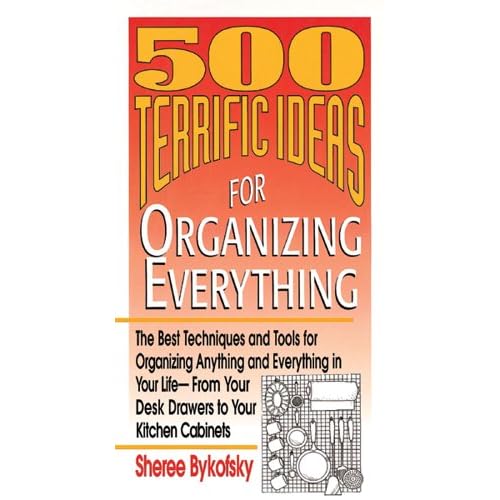
I'm a paper queen, and I'm always getting lost on my own convoluted paper trails. (Trails? What trails! my paper collection is more like a thick overgrown forest). Therefore, getting better organized tops my To-DO list for the next 12 months.
For advice, I turned to a book that I picked up for only $5.98 at a clearance table at a Barnes & Nobles store in Pittsburgh. The book is called 500 Terrific Ideas for Organizing Everything by Sheree Bykofsky.
It's available super cheap (for under a dollar) on this link (one penny and up for a used copy at Amazon.com) and prices are also low here. ($3.53 at Biblio.com)
The book is so well organized with separate categories and outside-the-box suggestions. Sometimes tip books frustrate me because the texts are filled with suggestions that make me smack my forehead and go: DUH!
But I may actually use some of the following hints in the MONEY section, which starts on page 97 of the book.
Here are a few of my favorite financial tips for organization:
1. New check register for each month: This strategy is good for tax time, makes it easier to check old records and it's a good discipline. I'm going to try this tip in January 2007. This monthly review will also provide an excellent snapshot of my monthly expenses and prompt me to really study my spending each month.
2. Portable financial file: Keep your check register armed with the following, pen, deposit slips and calculator. Time is money and I've lost a fortune scrambling for supplies in my purse.
3. Credit card register: I don't shop with credit, but if I did (Sorry about OJ language), I would use a check register to track my credit card balance and statement. Payments, balances and purchases are recorded day-by-day, transaction-by- transaction just like a checking account. When your available balance on the credit card hits or nears zero: leave the card home!
4. Receipt drawer/bill-payment center: I am so over my creative artist-writer phase. It's time to get a grip on my paper castles. I will allocate one drawer for receipts and designate one area as my "bill paying station." The author has a few creative suggestions. I can collect my bills in: a napkin holder, a sterling toast tray or a box. But the wisdom is this:
designate one central place with bills and supplies, such as stamps, calculator, pen, labels or whatever.
5. Anti-theft device: Somewhere I read or heard this bit of advice from career criminals: Don't hide your valuables in your underwear drawer. Thieves always look there. The author of the 500 tip book offers these anti-theft hiding places for emergency cash and safe-deposit keys: try the pet food box (please warn family members and don't recycle the pet food container)..or stash valuables in an envelope taped to an inexpensive wall hanging.
I recommend those hiding places, but having made that recommendation, I'm not using either.
6. Photo records: Use either a digital camera or your cam recorder to take photo images of your valuables and key financial documents. In case of an emergency, theft or natural disaster, G-d forbid, this recorded information is valuable.
______________
The Frugal Duchess Boutique
____________
No comments:
Post a Comment